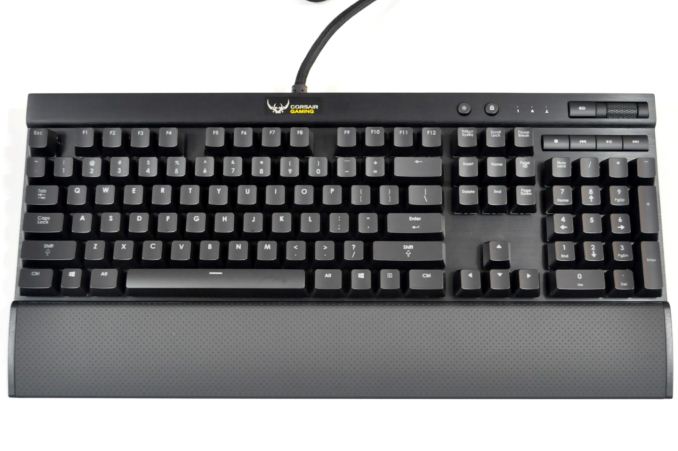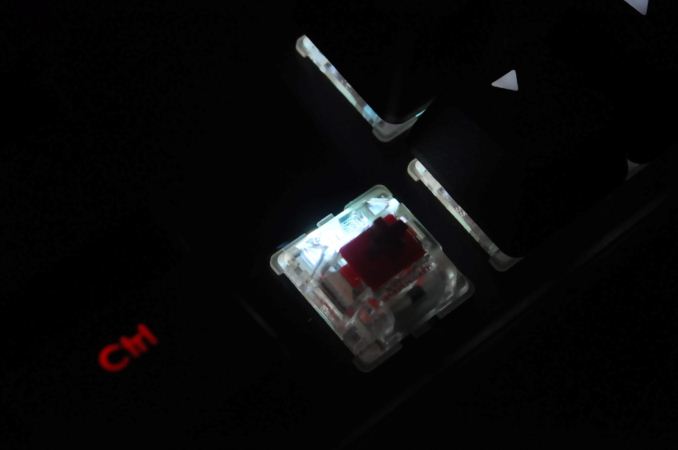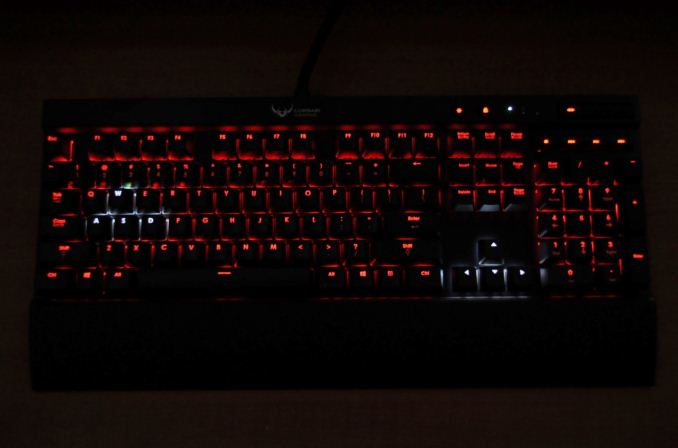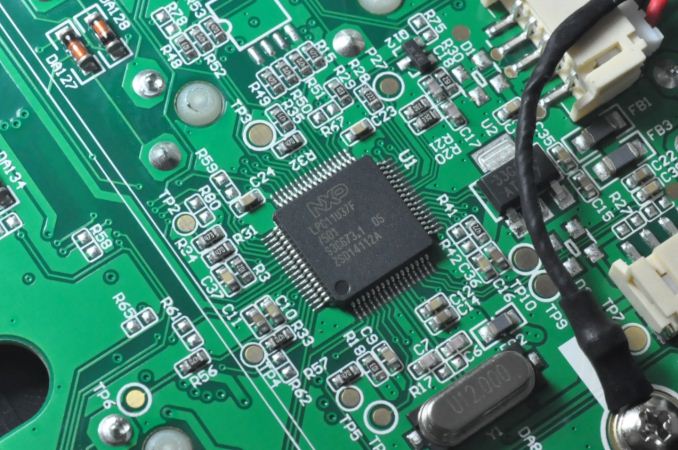Corsair Gaming K70 RGB Mechanical Keyboard Review
by E. Fylladitakis on September 22, 2014 9:00 AM EST- Posted in
- Keyboard
- Peripherals
- Corsair
- mechanical
- RGB Backlighting
With the exception of the new logo, the Corsair Gaming K70 RGB looks identical to the Vengeance K70 that we reviewed a few months ago. It features an anodized brushed aluminum chassis, with the keys secured directly on its surface rather than being embedded into it. Aesthetically, some people love this design while others hate it. With aesthetics being a completely subjective matter, we will let you decide what you think about the appearance of the K70 RGB. From a purely practical point of view, the Corsair Gaming K70 RGB is extremely easy to clean, as a simple blow can remove all debris from the aluminum surface of the keyboard.
Besides the typical 104 keys of a full-sized keyboard, the K70 RGB also has seven extra keys and a volume control knob. Four of them are media control keys (Play/Pause, Stop, Forward, and Back), one is the volume mute button, and the two smaller keys towards the center are the windows key lock and the backlighting brightness control. Three very small white LED lights serve as the three standard key lock indicators (Caps Lock, Num Lock, Scroll Lock). The LED lights of the indicators are the only lights that are not customizable on the K70 RGB as, most likely due to their tiny size, Corsair was forced to install just white LED lights under them.
The Corsair Gaming K70 RGB is available with three types of Cherry MX switches: red, brown, and blue. Cherry MX Black switches are not very popular due to their stiffness, so it is understandable that Corsair skipped them entirely. We received the version with the Cherry MX Red switches for our review.
The Cherry MX Red switches are relatively soft and linear, with no tactile actuation feedback, making them the most comfortable and least noisy mechanical switch. Make no mistake, the Cherry MX Red is not anywhere near noiseless, as mechanical switches will always make a sound once they bottom down. The only thing that is missing is the audible click at the actuation point, which is especially loud in the case of the Cherry MX Blue switches. The lack of tactile feedback dissuades some users, more commonly typists, who enjoy the tactile feeling, and even sound, of other switches. However, this is not an absolute rule and the selection of switches greatly relies on the preferences of the user.
Beneath the typical black keycaps are the new Cherry MX RGB switches. There is a major difference between the typical Cherry MX switch and the Cherry MX RGB switch that Corsair is using and that is how the lighting is implemented. The switch may be identical in terms of behavior and performance but, instead of a single LED at the top of the switch, the body of the switch itself is transparent and there are RGB LED lights installed in it.
The transparent body of the switch absorbs and diffuses the lighting evenly around the switch, creating a lighting effect far superior than what we previously seen with RGB backlighting in keyboards. Regardless, due to the position of the LED lights, the top character of the keycap is brighter than any bottom character (if present).
The keys of the Corsair Gaming K70 RGB feel very solid and cross type supports can be found under the five long keys (Space, Shift, Enter, and Backspace), which prevent the keys from wobbling. Cross supports will also distribute the actuation force, meaning that the key will require about the same actuation force regardless of the pressure point.
As far as lighting customization goes, if you can think of it, the Corsair Gaming K70 RGB can probably do it. Besides the limitless selection of colors, each single key can be programmed to a different color, brightness, and/or effect. Keys can be grouped in order to produce effects that are more complex, and lighting effects can be programmed to initiate when specific events take place (e.g. when a macro is initiated or when a timer ends). Different lighting settings can be programmed for each profile, even for each different mode. We will examine some of these options on the following page as we go through the new CUE software.
Despite the thick cable and two USB connectors, the Corsair Gaming K70 RGB has no USB ports at all, which is a downgrade over the previous Vengeance K70 that had one USB port. At the back of the keyboard there's a switch that can adjust the polling rate of the keyboard. This function will be useless with modern systems but may enhance the compatibility of the keyboard with older systems and certain devices, such as cheap KVM switches. The default polling rate is 1ms (or 1kHz) and the user can reduce it to 2ms, 4ms, or 8ms.
There is also a fifth mode, the "BIOS" mode, which converts the Corsair Gaming K70 RGB into a typical 104-key keyboard, disabling the media keys and all advanced features. This mode offers maximum compatibility and is most likely reserved only for very old systems or certain BIOS versions. In this mode, the Scroll Lock LED indicator will blink. Frankly, it's doubtful anyone would use a keyboard such as this with a system that couldn't properly support all of the advanced features, but it might be useful at times for debugging purposes.
Beneath the keyboard are four feet for height adjustment, two at the rear and two at the front. Although stands at the rear of the keyboard are quite common, very few designs have the ability to adjust the tilt at the front.
Under the aluminum chassis we find excellent assembly work. The soldering job is textbook, without a single flawed point. Not unsurprisingly, the processor inside the Corsair Gaming K70 RGB is not a commonly seen Freescale processor, like the one we found in the Vengeance K70, but instead it's an NXP LPC11U37F-501. This microcontroller has about the same processing power as the commonly used Freescale MC9S08JM32, but it has four times the flash memory, six times the static RAM, and eight times the USB RAM.





















91 Comments
View All Comments
lehtv - Monday, September 22, 2014 - link
So they sent Dustin over to Corsair, and in return, Corsair sent Fylladitakis to AT? Makes sense.Sabresiberian - Monday, September 22, 2014 - link
I don't have a problem with it. I find his writing to be quite thorough and logical. Certainly in the grand scheme of today's internet writers it stands well above the average.You might also consider that English might not be his first language (though judging by name is far from accurate, especially in the modern world), or that he comes from a country where English varies slightly from American--English. Regardless, minor grammar or editing mistakes don't mean the writing is "poor" overall. I get that many people talk like a politician running for office these days - in other words, grossly exaggerate or use inflammatory language - but that is no excuse for calling a person's writing "poor" when it isn't.
I suggest you make such remarks very specific, about the exact phrase or word that bothers you. You might also consider sending him a polite PM instead of posting in a public thread.
JarredWalton - Monday, September 22, 2014 - link
FWIW (and this is for the OP and thread in general, not to Sabresiberian) I do an editing pass on all of E.Fyll's work as you're correct: he's not a native English speaker. Sadly, I've been known to miss a typo or two, or even introduce my own errors -- our CMS does have a spell-checker, but I did the editing pass on a different PC early this morning and didn't realize the spell-checking wasn't turned on. Even then, the CMS doesn't catch potential grammar issues, and copying into Word and back becomes rather tedious. I just made a second pass looking for spelling errors and found several that I had missed, but I'm sure there are a few others.Personally, I view our reviews (and most computer hardware reviews) as being more useful from an informational standpoint than literary works that need to have perfect grammar in order to convey their intended message. We try to catch errors, but in the world of the Internet and with sometimes short review periods it's inevitable that we'll miss some things. Hopefully most of you can still enjoy the technical content, even if we sometimes mangle the English language. :-)
bebimbap - Monday, September 22, 2014 - link
Overall I enjoyed the review and agree with your conclusion. I don't care about he "advanced key options" and the extra 60% cost compared to the vengeance series is too much.I find your writing good, as I am able to read it without becoming confused or rattled.
I believe what people are complaining about is the smoothness of the style. On the last page, the first paragraph begins in 2nd person as "you" are the target audience. But later in that same paragraph the audience is switched to 3rd person "the user". 2nd paragraph is written in 3rd person, and the 3rd paragraph is written in 2nd person again. The 6th paragraph is written in 1st person, and so forth. For some people a single skip on a CD track makes the entire CD unusable, but not myself, as long as it keeps flowing. This style does not bother me. I read for information, and you have gotten your point across on every front. Writing is first and foremost the exchange of information, and you have accomplished that.
If you take Dr Ian's writing style as an example he usually keeps most of his paragraphs in 3rd person, and is written more like a lecture or a scientific paper at times which I enjoy reading.
Dustin's writing has a lot of passion and is more colloquial and less traditional, and writes in mostly 1st person. He writes with rhetorical questions which engage the reader which I also enjoy reading.
In the end every author writes differently and they should. I do not want the same person writing every review.
E.Fyll - Monday, September 22, 2014 - link
I do see your point and appreciate your feedback. Actually, I am to blame for this. You could say that it is the price I pay for "not being myself". My usual writing style is in third person: it also is very formal, short and abrupt. I have been (rightfully) accused of having a bland, cold writing style. I do realize that a strict, formal and direct text is not exactly suitable for this line of work, so I try to "liven it up" a little by either trying to write as if I am lecturing or by narrating my own ideas and experiences - hence the inconsistency. The switching is not ideal but, for example, it is difficult to narrate your own experience in third person without suggesting that it is not your own experience but "a universal truth". Clarity is always my top priority, I do not want to leave room for misconceptions, so it will always take precedence over uniformity when necessary.I suppose that it might work best if I stick with the third person writing for the majority of the text and switch to first person in paragraphs that describe my own views and experiences.
Dustin Sklavos - Monday, September 22, 2014 - link
Write in whatever voice you're most comfortable with and then slowly develop from there. My early stuff here was really stilted because I'm *not* comfortable writing academically. Once I realized I could use my preferred style, it got much easier.Academic and formal is almost more appropriate for AT than my writing style ever was. Ignore the local yokels and just write how you want to write.
nathanddrews - Monday, September 22, 2014 - link
On the contrary, I thought it was an excellent article. I'd be all over this keyboard if it came with MX Black keys.YazX_ - Monday, September 22, 2014 - link
i have no problem with the writer, he did a great job here and in other articles, if you have a problem then its your own problem and i would suggest you move on or go else where.typos are common when writing any article, so stop crying like babies and get to the core of the article not the writer.
DigitalFreak - Monday, September 22, 2014 - link
If you want to see some bad review writing, try reading video card reviews at HardOCP. Almost painful.Dustin Sklavos - Monday, September 22, 2014 - link
While I'd almost take that as a compliment, I remember getting comments just like this one when I started at AT. I had one person say I needed to be fired.Your feedback isn't constructive, it's not helpful in any meaningful way, the only purpose it serves is to be hurtful while you hide behind the internet. E.'s writing is fine, it's just more academic in style than mine was. Different is not worse or better, it's different. But E.'s methodology (at least with cases and cooling) is more sound than mine was, E. can do extremely detailed PSU reviews, and he happens to be picking up peripherals.
As for the typo you guys are griping about, I was corrected roughly once an article. It happens.
E. has my complete confidence, support, endorsement, whatever you want to call it. I *like* my successor. If it had been up to me I *still* would've chosen him.